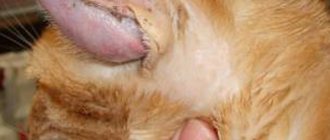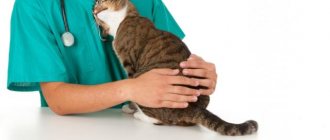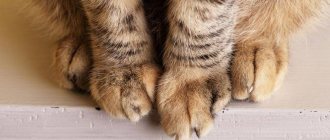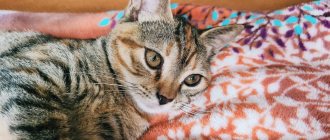Ataxia is a coordination disorder. As a symptom, it often accompanies diseases after damage to the central nervous system (CNS). In addition, the cat does not exhibit any chaotic movements, convulsions or paralysis. Muscle tone in the paws is either completely normal or very slightly reduced.
Ataxia can be static or dynamic. In the first case, the animal is not able to maintain balance even while standing still, and in the second, the cat is thrown from side to side, but only while moving. It is divided into 3 broad groups depending on the location of the lesion.
Cerebellar ataxia
In this case, the motor pathology was provoked either by a genetic factor with a developmental defect in the brain structures, or by a mother cat who developed panleukopenia in late pregnancy.
In kittens, hypoplasia of the cerebellum occurs, which controls coordination and regulates voluntary and involuntary movements.
The unusual nature of the kitten becomes obvious when the babies grow up and begin to move actively. And in some cases, particularly attentive owners can detect violations immediately after birth. Most cats with cerebellar ataxia move sideways or diagonally.
Cerebellar ataxia differs from other types of ataxia: nystagmus - involuntary very rapid movements of the eyes, trembling of the head when the animal is focused on something, and tremor of the back of the body during movement. When the cerebellar vermis is damaged, static-locomotor ataxia develops.
According to the severity, it can occur in mild, moderate and severe form. With mild, falls occur periodically, the cat actively walks and runs; with moderate, movements are not easy for the animal, the cat often falls, but still moves. And the severe degree does not even allow you to get up on your paws.
Unfortunately, the disease cannot be treated. But with proper care, a kitten has every chance of living as long as an ordinary healthy cat. He does not experience any pain, his intelligence is completely preserved, and after the age of 1 year, movements become more coordinated and consistent. If deterioration begins, this only indicates that another neurological disease with similar symptoms has joined the ataxia.
By nature, cats with cerebellar ataxia are very affectionate and friendly. Owners of such animals note their unusual intelligence, close emotional connection and strong affection. Throughout its life, a cat perceives its owner or mistress as a big mother.
Reference!
The same litter may produce kittens with varying degrees of cerebellar damage.
Causes
Prerequisites can be inherited or acquired. Congenital predisposition is characteristic of cerebellar ataxia. Pathological signs appear by six months of age. However, the cerebellar variety can also be acquired.
The most likely causes of uncoordinated movements include the following:
- viral infections: with panleukopenia, kittens predisposed to ataxia are born in mature females;
- back or skull injuries;
- otitis of parasitic, allergic or infectious origin;
- poisoning
Vestibular ataxia
The diagnosis is made in two cases: with an affected structure of the inner ear and with tumors of the brain stem or medulla oblongata.
Adult animals over 10 years of age are most susceptible to the disease. The cat has difficulty standing, can walk in circles, or fall over on one side.
The head is either thrown back or tilted towards the affected side. Movements are slow and careful. Concomitant strabismus and nystagmus are often found, and in some cases there is also periodic vomiting.
The appearance of vestibular ataxia is provoked by:
- otitis;
- brain tumors;
- bacterial infections and abscesses of the ear canal;
- excessively intense and traumatic ear cleaning;
- medication overdose;
- use of aminoglycoside antibiotics;
- liver or kidney dysfunction (in rare cases).
Attention!
A cat with an affected vestibular apparatus may periodically sit in a corner with its forehead pressed against the wall. We often see this exact pose of the animal in a series of “funny” photos. Meanwhile, the pet is suffering from a severe headache and is in dire need of veterinary care.
Sensitive ataxia (proprioceptive)
The consequence of damage to either the posterior columns of the spinal cord, or its roots, or peripheral nerves.
Similarly, there are pathologies of the parietal lobe cortex and thalamus opticus. Tumors and diseases of the intervertebral discs in cats also affect the development of sensitive ataxia.
The main problem is that the animal is not able to bend and straighten its limbs at the joints. The ability to consciously determine the direction of movement is lost.
There is pain in the neck and back area, movements are also painful, and the cat tries to move as little as possible. In severe cases, any movement is simply impossible.
If the brain is damaged in a small part, and treatment was prescribed as quickly as possible at an early stage, there is a chance that the animal will return to normal healthy life.
Localization of damage in ataxia
Stroke in cats: symptoms and treatment, first signs
Depending on the location of the source of inflammation, the pathology is divided into the following groups:
- Cerebellar - appears with inflammation of the medulla oblongata and cerebellum. The disease can be either congenital or acquired.
- Vestibular - with inflammation of the inner ear system.
- Proprioretic - a form caused by damage to peripheral nerves.
- Spinal cord develops against the background of damage to the spinal cord.
In veterinary medicine, there are two forms of ataxia:
- static;
- dynamic.
In the first case, the kitten will not even be able to stand straight; in the second, on the contrary, coordination is impaired only during movement.
Pathology in kittens from birth
Causes of ataxia in cats
There are several reasons why you can directly encounter ataxia. Some can be prevented, the likelihood of others depends little on us, but we need to know about them at least in order to quickly respond if necessary:
- genetic inheritance;
- infectious diseases causing pathologies of the central nervous system and brain;
- cerebral edema;
- traumatic brain injuries;
- severe poisoning with toxins, household chemicals;
- hunger or systematic malnutrition;
- acute deficiency of B vitamins and folic acid.
General symptoms
In addition to individual signs of the disease, characteristic only of one of its forms, there are several general symptoms by which ataxia can be identified:
- The cat has a wobbling gait with drifts to the side.
- When walking, the paws are widely spaced; The animal seems to be constantly afraid of falling.
- Often falls while walking or running.
- Rarely holds head straight; more often - with an inclination to the side or down.
- Does not control her body: even with fairly confident walking, she is not able to jump, go down/ascend, or turn around a turn.
- In severe cases, he cannot consistently perform the simplest movements. Remains in one place, but wobbles a lot and falls.
- Partially or completely not oriented in space. Bumps into objects and does not know how to calculate real distance.
Diagnostics
Often, to a professional veterinarian, ataxia is obvious upon initial examination. But to fully understand the situation, it is necessary to collect all the anamnesis data. Have there been any injuries (even several years ago), how and what does the cat eat, what severe infections has it suffered? If possible, how her mother’s pregnancy progressed. Examination of the ears with an otoscope is mandatory.
X-rays, ultrasound, or even an MRI will be needed to confirm the diagnosis and identify or rule out tumors, hemorrhage, or swelling of the brain. In some cases, if a brain or spinal cord infection is suspected, a cerebrospinal fluid test may be necessary.
Treatment on an outpatient basis and at home
The entire treatment regimen for ataxia, if possible and relevant, always directly depends on the root cause of the disease. Therefore, the list of prescriptions and dosages of drugs are never the same, even for the same form. And in this section we will provide only generally accepted medical recommendations in practice:
- Vitamin complexes following the example of Gamavit and especially B vitamins are always required;
- antibiotics will be needed if the cat is fighting an infection;
- diuretics - Furosemide, Veroshpiron - will help in the outflow of excess fluid during cerebral edema;
- in case of damage to the spinal cord (sensitive ataxia) - surgical intervention;
- for intoxication - droppers of saline solutions and glucocorticosteroids;
- severe muscle tremors can be treated with caution with Diazepam;
- Cerebrolysate - to improve cerebral circulation;
- Physiotherapy - UMI, UHF, massage;
- Piracetam, Cavinton and Glycine - to restore cerebral functions.
Important!
Please remember that any information on the Internet is for informational purposes only. Never prescribe medications to your cat without first examining and consulting a veterinarian.
How is the treatment carried out?
The treatment strategy is determined by the cause of the ataxia. In all cases, to restore the conduction of nerve impulses, group B drugs are injected. The specialist prescribes medications that improve cerebral circulation and normalize metabolic processes in nerve tissues.
If a tumor is found, it is removed. Prescription psychotropic medications are used to stop tremors. If the disease is accompanied by cerebral edema, diuretics are prescribed. If necessary, antibiotics are prescribed, as well as rehydration therapy. In some cases, the specialist offers the owner a choice between continuing treatment and euthanasia.
If ataxia is detected in a kitten, the pathological symptoms may disappear upon reaching one year of age.
Prevention of ataxia
Despite the fatality of this disease, you still have too many conditions in your hands for a full and healthy life for your pet.
- Eliminate all factors that could cause serious serious injury. It is advisable to limit unsupervised walks on the street. And if you live in a multi-story building, a mosquito net on the windows will simply save the animal’s life.
- If you suspect a traumatic brain injury, immediately take your cat to a veterinary clinic or, at a minimum, immediately consult a doctor by telephone.
- Strictly follow the vaccination schedule against panleukopenia, rhinovirus and leukemia.
- Do not under any circumstances start treatment for otitis media or any inflammation in the ears.
- When planning a mating, pre-examine the cat for panleukopenia.
- During pregnancy, protect her from any contact with other animals.
- When purchasing a kitten from breeders, try to find out in as much detail as possible the course of the mother’s pregnancy and possible genetic problems along the family line.
Reference!
Problematic coordination of movements of a cat with ataxia is very well corrected by physical therapy. Exercise and play with the animal as often and for as long as possible. This not only brings him a lot of positive emotions, but is also a necessity when he is ill.
Let's sum it up
The owner of the animal must understand that causing him suffering is not the best choice. Cats are naturally very active, easy-going and playful, so the inability to control their own body becomes real torture for them. Ataxia is an incurable disease unless it is provoked by a specific factor that can be removed. Therefore, the owner of a cat suffering from ataxia has only one option - to look for an attentive and qualified doctor, conduct an examination, discuss the treatment regimen with him and monitor the pet in order to notice deterioration in time.











